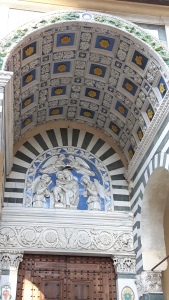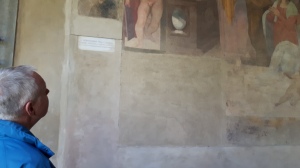It has been a long time since my last post. Some of you may wonder whether I decided to remain in Italy permanently. Others know that I’ve been back in Canada for a while—which explains, at least in part, this tardy return to the blog. Once back from any trip the routine harness latches on tightly and life commitments have a way of taking over.
Or is that just an excuse? Perhaps, the problem is that this post deals with another departure. . .
Leaving can be exciting or leaving can be hard: For me, leaving Italy is always hard.
As a child I was heartsick at having to board that ocean liner, that train, that plane, whatever method would take me away from the family and places I loved. Back to a land and people I didn’t remember and did not feel tied to. Even as an adult, when there were many people and things I belonged to in my Canadian home, even though logic dictated that Canada was, without a doubt, a more sane place to live, the pull to stay in the land of my roots was, at times, suffocating.
Over the last twenty years I have become a little more resigned, a little more pragmatic about my frequent departures. My responsibilities, after all, lie across the Atlantic and fully across another continent—I have carried with me 9000 kilometers’ worth of resignation. On this visit, however, I dropped the load.
These were the thoughts jostling in my mind as we drove away from the agriturismo towards Florence on a bright, hot Spring Sunday. I had five days left. The countdown was on.
We made a pit stop at Antonella’s house to drop off our suitcase and to pick her up. Together we drove to Pistoia, forty-five minutes north, where she and her group were giving a concert at San Domenico, an ancient Domenican monastery in center of the city. When we arrived the band was already setting up under the portico which lined one side of the monastery; chairs had been set up in front, waiting for the audience. An older gentleman with dancing eyes immediately came over to welcome us and offer us an espresso—an instant friend! He introduced himself as Alberto and I later learned that he was one of only three friars remaining in this 13th century monastery. Once these three were gone, the large complex—church, cloister and living quarters—would no doubt be re-purposed, as so many have been in the past twenty years. But for now it was a living parish and one which had just hosted a weekend retreat. Antonella’s group was the entertainment which would end the proceedings.
While the band continued with soundchecks and attended to all the technical details which a concert entails, Alberto took us to a room off the oldest cloister to see a beautiful 13th century fresco of the Crucifixion and its sinopia. He was obviously very proud to show off this hidden treasure. With his church’s diminished role in the community, few people now wandered through its halls and rooms. The opportunity to share these gems was rare. But we were a captive and very appreciative audience. For Antonella and me, it was a perfect ‘full circle’ moment, a shadow of that March day in Florence when we stood, enthralled by the Cenacolo by Ghirlandaio, and by the amazing story of the discovery of its sinopia—by chance—during the 1966 flood. (See the April post Vecchio e Nuovo — Old and New).
We also took the time to wander into the cavernous church, last updated in the 19th century, and certainly more interesting than beautiful, in my opinion. There was an air of sadness about it, empty as it was, in the middle of a Sunday afternoon, as though waiting, resigned, for a municipal committee to determine its future use.
After visiting the Church, it was time to rush back to the portici overlooking the garden: the concert was about to begin and the Valter Vaioli Band was missing its lead singer! We spent a lovely afternoon listening to the band and to Antonella’s strong voice, so suited to Valter’s original songs of love, and re-interpreted Gospel stories. I was sitting with John, my cousin Roberta, Anto’s youngest sister, and her boyfriend. A family outing on a hot Spring afternoon. I couldn’t help thinking that if I lived here this would be a normal occurrence. An old familiar feeling began its climb up my throat and settled in my eyes.
After the concert and a warm goodbye to Alberto the five of us decided to stroll into the center of Pistoia in search of gelato.
It was late afternoon when we immersed ourselves in the Sunday crowds. Caught in the slow-moving stream, we chatted as we enjoyed our cold treat, and took time to admire Pistoia’s architectural beauty, knowing we were skimming only the surface. That day, stunning Renaissance art and structures settled comfortably into the background. The best part, for me, was simply strolling with my cousins in the din and chaos of the weekly Sunday afternoon ritual: Parents, children, grandparents, friends and lovers, all flowing through now mostly-shaded streets or milling in the piazzas, enjoying the cooling city before heading to a restaurant or home for a light evening meal. Heaven.
Back in Florence, there was a frenzy of packing and last-minute shopping for family and friends back home. Time was spent swimming through tourists and leather at the open air Mercato di San Lorenzo and its delicious covered counterpart, the Mercato Centrale.
This last is a Foodie’s dream where, along with fresh vegetables, meat and fish, one can find dried mushrooms (not from Italy, unfortunately), olive oil, special vinegars, a head-spinning variety of cheeses, and mouth-watering breads and sweets to round off your culinary experience. To walk through the market is an immersion in a sensory feast: Artfully-arranged colours, heady smells, a constant din of voices, and the odd taste of rich olive oil on salt-free Tuscan bread.
On the second floor of the mercato there is now an Eataly which offers a variety of delicious food for consumption, in a modern-upscale-Manhattan kind of atmosphere—not exactly la vecchia Italia. If one prefers to prepare one’s own food before eating, cooking classes are available. Or. . . if money is no object, and the unique is what you crave, you can buy a decent-sized truffle for a mere $330,000 (American currency, of course). Buon appetito!
Satisfied that we had crossed off everyone on our list, we were able to relax a bit more and enjoy our last hours in Florence. I had not been inside the beautiful church of Santa Maria Novella in a number of years so we determined that she would be our last cultural experience in Italy. The church has its back to the main train station in Florence, so is located in a seedier part of town but that is forgotten when one stands at the front entrance. The large square before the beautiful facade is a wide-open gathering space for locals, tourists and youth—at all hours of the day and night. I’ve walked by when there were people picnicking, protesting, listening to soloists or bands, or simply resting in the sun on the stone benches by the large flower beds.
Santa Maria Novella is one of the oldest churches in Florence (construction of the Domenican convent was begun in 1279) and is a beautiful structure which contains works by Massaccio (Trinità), Brunelleschi (Crucifix, Gondi Chapel), Filippo Lippi, Ghirlandaio, among others. Very striking is one of Giotto’s early Crucifixes which hangs, as if floating, in the middle of the central nave of the church.
What I most look forward to, however, when I visit this basilica is the Tornabuoni Chapel behind the main altar and its magnificent stained glass windows and rich frescoes, all work of Ghirlandaio (completed in 1490). The frescoes on the left wall depict stories of the Virgin; the ones on the right wall, stories of Saint John the Baptist. All achingly beautiful.
On this particular day, a highlight of our visit to the basilica was when an elderly gentleman, cane in hand, got up near the front of the church and began a spontaneous rendition of an Angus Dei in a sonorous baritone. Security people standing by looked at each other, wondering whether or not to intervene, then shrugged their shoulders and just listened, along with the visitors. Afterwards, one guard approached the official nearest us and simply said, “Mah… Questo cantava anche bene,” (Well… this one sang rather well). Obviously, it was not the first time they had been subjected to an impromptu concert; my impression was that the decision to stop the ‘performance’, or let the musical interlude continue, was based solely on quality. This one had passed the test.
After visiting the Basilica, we exited by a side door and entered a series of three cloisters: il Chiostro Verde, the Green Cloister, il Chiostro Grande, the Large Cloister, and il Chiostrino dei morti, the Small Cloister of the dead, dating from before construction of the Church and Convent by the Domenicans. As we admired the frescoes covering the walls of the cloisters we were taken by a small plaque, almost a foot above John’s head, indicating the level reached by the flood waters of the Arno, in 1966. It was a sobering moment when we contemplated how ephemeral this beauty really is. Much of this art has survived centuries of political conflict, neglect, change in artistic preferences—even Nazi occupation—but the Arno waters would not be stopped. When Mother Nature sets her mind to ruin, she does not take national patrimony into account. When it comes to her, we are all here on borrowed time.
And my borrowed time in Italy had run out.
It was time to lock the suitcases (containing the freshest bomboloni I could find, packed in a sturdy container; a little bit of Italy for the family) and head to the airport.
It was time to say last goodbyes and wonder when I might return.
It was time to take stock of my experience, to be grateful for the opportunity I’d had to spend time by myself at my other home, and to acknowledge my great fortune at being part of two cultures, each equally important to me.
It was time to part from a beloved kindred spirit.
Buona notte e alla prossima!

















What a lovely way to wake up – with your beautiful descriptions and reflections on your time in Italy!
Thank you for sharing xo
Alanna
Sent from my iPhone
>
Grazie, Alanna! I hope that it brought back some fond memories from your recent trip as well 🙂
Daniela
Aaaaahhhh!!!! Beautiful, bella, fantastico!!! I couldn’t stop reading ~ you know how this speaks to my heart and soul. I am there, breathing it all in, with a longing and an ache. (and a smile) And the way in which you write about this experience is poignant and touches me deeply. I am familiar with the pieces of music you mention here, and am just about to listen them (via youtube) Thank you! Leeeeeeenda (as my Italian boyfriend Luigi, used to call me 😉
Grazie, Bella Leeeeeeenda! 😉
Grazie Daniela, I’m glad you’re home so we can share poetry and totally understand the pull you have to Italy (part from that it is your home!). I love it too, how small my experience was.
Grazie, Nancy.
Well, I’m glad to be back too, for many, many reasons — but that pull is never far from my heart. It does get a little easier as time and routine take over! :-0
Ci vediamo venerdì!
Daniela